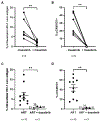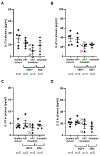Provirus reactivation is impaired in HIV-1 infected individuals on treatment with dasatinib and antiretroviral therapy
- PMID: 34186065
- PMCID: PMC8478809
- DOI: 10.1016/j.bcp.2021.114666
Provirus reactivation is impaired in HIV-1 infected individuals on treatment with dasatinib and antiretroviral therapy
Abstract
The latent viral reservoir formed by HIV-1, mainly in CD4 + T cells, is responsible for the failure of antiretroviral therapy (ART) to achieve a complete elimination of the virus in infected individuals. We previously determined that CD4 + T cells from individuals with chronic myeloid leukemia (CML) on treatment with dasatinib are resistant to HIV-1 infection ex vivo. The main mechanism for this antiviral effect is the preservation of SAMHD1 activity. In this study, we aimed to evaluate the impact of dasatinib on the viral reservoir of HIV-infected individuals with CML who were on simultaneous treatment with ART and dasatinib. Due to the low estimated incidence of HIV-1 infection and CML (1:65,000), three male individuals were recruited in Spain and Germany. These individuals had been on treatment with standard ART and dasatinib for median 1.3 years (IQR 1.3-5.3 years). Reservoir size and composition in PBMCs from these individuals was analyzed in comparison with HIV-infected individuals on triple ART regimen and undetectable viremia. The frequency of latently infected cells was reduced more than 5-fold in these individuals. The reactivation of proviruses from these cells was reduced more than 4-fold and, upon activation, SAMHD1 phosphorylation was reduced 40-fold. Plasma levels of the homeostatic cytokine IL-7 and CD4 effector subpopulations TEM and TEMRA in peripheral blood were also reduced. Therefore, treatment of HIV-infected individuals with dasatinib as adjuvant of ART could disturb the reservoir reactivation and reseeding, which might have a beneficial impact to reduce its size.
Keywords: CD4+ T cells; Dasatinib; HIV functional cure; HIV reservoir; Proviral reactivation; SAMHD1.
Copyright © 2021 The Author(s). Published by Elsevier Inc. All rights reserved.
Conflict of interest statement
Declaration of Competing Interest
The authors have declared that no conflict of interest exists.
Figures





References
-
- Finzi D, Hermankova M, Pierson T, Carruth LM, Buck C, Chaisson RE, Quinn TC, Chadwick K, Margolick J, Brookmeyer R, Gallant J, Markowitz M, Ho DD, Richman DD, Siliciano RF, Identification of a reservoir for HIV-1 in patients on highly active antiretroviral therapy, Science 278(5341) (1997) 1295–300. - PubMed
-
- Wong JK, Hezareh M, Gunthard HF, Havlir DV, Ignacio CC, Spina CA, Richman DD, Recovery of replication-competent HIV despite prolonged suppression of plasma viremia, Science 278(5341) (1997) 1291–5. - PubMed
-
- Chun TW, Davey RT Jr., Engel D, Lane HC, Fauci AS, Re-emergence of HIV after stopping therapy, Nature 401(6756) (1999) 874–5. - PubMed
Publication types
MeSH terms
Substances
Grants and funding
LinkOut - more resources
Full Text Sources
Medical
Research Materials
Miscellaneous

